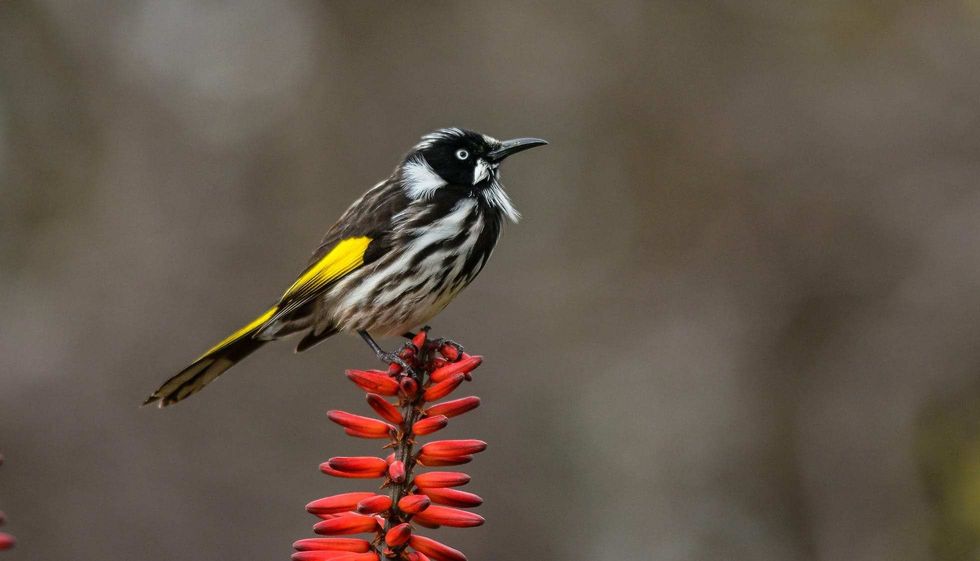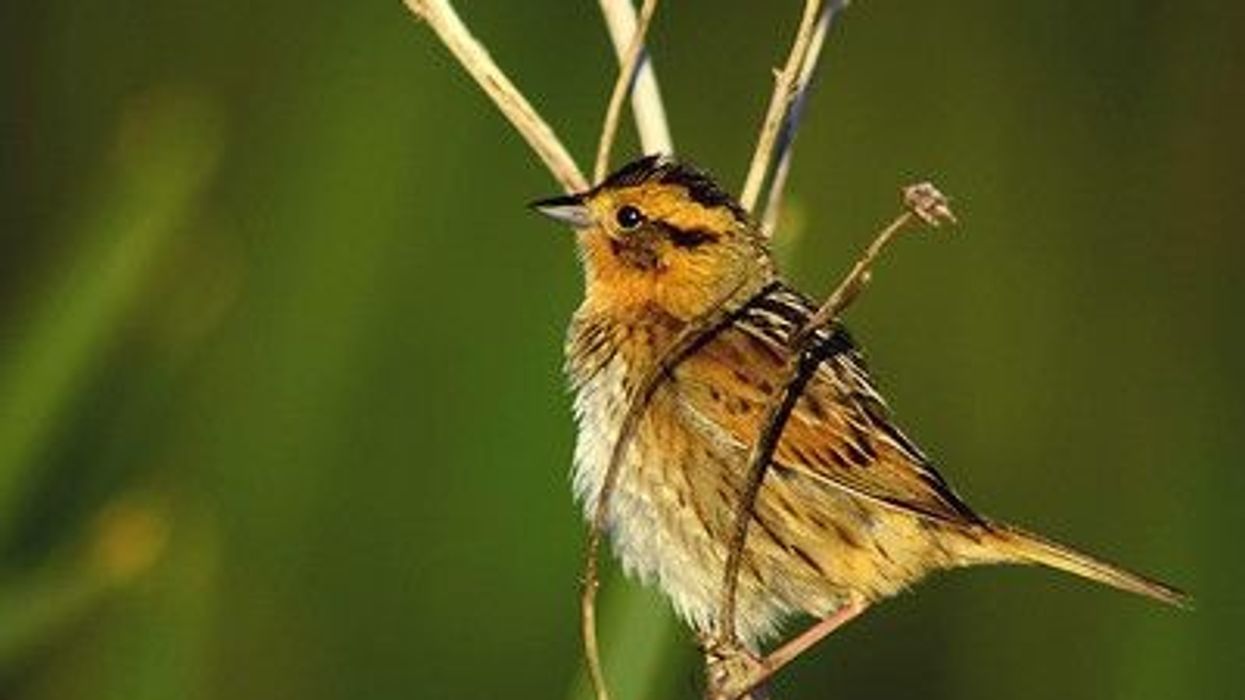The New Holland honeyeater (Phylidonyris novaehollandiae) is a beautiful bird that belongs to the order Passeriformes and the family Meliphagidae. It is closely related to the white-cheeked honeyeater and this bird has a black and white coloration primarily.
It also has yellow patches on its wing and tail feathers and it possesses a white eye and a white-colored thin whisker at the base of its bill. Female and male birds look similar to each other, however, the female is smaller.
The habitat of this bird includes forests, gardens, woodlands, and heath habitats. It dwells in places where banksias and grevilleas can be found.
This mesmerizing bird species can be found across southern Australia, starting from Queensland towards the north of Perth in western Australia. The diet of this species comprises flower nectar, fruit, insects, and spiders, so they can be seen darting from flower to flower to search for food that can provide them high levels of energy.
Birds of this species are also spotted feeding alone sometimes but they usually feed in large groups. The feeding usually takes place in thickets and bushes and the nest is constructed in a tree or a bush.
If you enjoy reading these New Holland fun facts, you must continue reading to discover interesting facts about the feeding habits, physical description, breeding, and habitat of these birds. You can also check out our amaze-wing Anna's hummingbird facts for kids and whiskered treeswift interesting facts!
New Holland Honeyeater Interesting Facts
What type of animal is a New Holland honeyeater?
The New Holland honeyeater (Phylidonyris novaehollandiae) is a magnificent bird that belongs to the family Meliphagidae. It is closely related to the white-cheeked honeyeater. The New Holland honeyeater is an active bird that rarely sits in one place for long durations.
What class of animal does a New Holland honeyeater belong to?
The New Holland honeyeater (Phylidonyris novaehollandiae) belongs to the class Aves and the order Passeriformes.
How many New Holland honeyeaters are there in the world?
The total population size of New Holland honeyeaters has not yet been evaluated. However, the population of these birds is described as locally abundant by the IUCN. The population trend of these birds is also suspected to be stable. These birds do not face any significant threats and there is no evidence of any decline in their population.
Where does a New Holland honeyeater live?
These birds can be spotted across southern Australia starting from Queensland towards the north of Perth in western Australia. They are found in Australia commonly but it is not known if they are native to the region.
What is a New Holland honeyeater's habitat?
This species dwells in forests, gardens, woodland, and heath habitats. It prefers to inhabit places where grevilleas and banksias are present.
This species also has an inquisitive nature and often approaches humans to investigate them. It also shares habitats with other species of honeyeaters like crescent honeyeaters, Lewin's honeyeaters, and brown honeyeaters. The nest of this bird is built from grasses and bark and the nest is held together by the web of spiders.
The nest is placed in a tree or in a bush and it is also lined with smooth materials. The nest can be found at an elevation of 19.6 ft (6 m) typically.
Who do New Holland honeyeaters live with?
Birds of this species can be spotted foraging alone as well as in a large group. They can be seen in pairs during the breeding season.
How long does a New Holland honeyeater live?
Birds of this species have an average lifespan of two years. The oldest living bird of this species was 14 years old!
How do they reproduce?
The breeding season of New Holland honeyeaters lasts from spring to autumn in eastern and southern Australia. However, the coastal population of this species has been observed to breed during any season depending upon the weather and the availability of food.
Males spend a large amount of their time protecting their nest whereas females spend their time building the nest, incubating the eggs, and then caring for the chicks.
The nest houses two to three New Holland honeyeater eggs that are incubated for 18 days by the female honeyeater.
The chicks stay in the nest for a period of 16 days during which time, both sexes feed the chicks. A pair of these species can produce two to three broods in a single year.
What is their conservation status?
These birds are classified under the Least Concern category by the IUCN's Red List.
New Holland Honeyeater Fun Facts
What do New Holland honeyeaters look like?
New Holland honeyeaters have black and white-colored plumage with splashes of yellow in some regions. The bird possesses a yellow-colored wing patch as well as yellow-colored tail feathers. It also possesses a white eye and a small white ear patch.
It also possesses a white-colored thin whisker at the base of its bill. This species exhibits sexual dimorphism; the female honeyeater is slightly smaller than the male honeyeater.
Adults possess a white iris and white-colored facial tufts. Both male and female birds of this species look utterly magnificent and are similar in looks. Their chicks have a brown coloration and possess gray-colored eyes.

How cute are they?
New Holland honeyeaters look magnificent. New Holland honeyeaters have a beautiful black and white plumage and they sport bright yellow tail feathers and a yellow-colored wing patch.
There is also a splash of white on their plumage as they possess a small white ear patch. As they are quite active, you might miss observing the characteristic white-colored thin whisker present at the base of their bill.
They are certainly cute and anyone would be lucky to spot one of these birds within the New Holland honeyeater range map!
How do they communicate?
The New Holland honeyeater song comprises sounds like 'pseet' and 'chik'. There are also a few chattering notes sung. A group of honeyeaters comes together and gives noisy alarm calls if they suspect that there is a bird of prey nearby.
How big is a New Holland honeyeater?
These birds range between 6.6-7.2 in (17 - 18.5 cm) in length. They are slightly bigger than the European goldfinch!
How fast can a New Holland honeyeater fly?
The speed of the New Holland honeyeater has not yet been evaluated. However, we do know that crescent honeyeaters can fly at a top speed of 55 mph (80 kph).
How much does a New Holland honeyeater weigh?
These birds range between 0.6-0.9 oz (18-28 g) in weight.
What are their male and female names of the species?
There are no distinct names for males and females of this honeyeater species.
What would you call a baby New Holland honeyeater?
A New Holland honeyeater baby is referred to as a chick!
What do they eat?
The typical New Holland honeyeater diet comprises the nectar of flowers so they can be seen darting from one flower to another to search for food to provide them with high levels of energy. They are also known to consume fruit, insects such as bees, and spiders.
Birds of this species are spotted feeding alone sometimes, but they usually feed in a large group.
These birds can be often spotted near bankesia flowers. Honeyeater species are known to become prey to currawongs, corvids, butcherbirds, snakes, and birds of prey like eagles and hawks.
Are they dangerous?
No, birds of this honeyeater species are not dangerous.
Would they make a good pet?
The New Holland honeyeater is a very energetic and active bird. It rarely sits in one place for long durations, so keeping them in a cage could prove to be stressful for them. It is better to not keep this bird as a pet.
Did you know...
The New Holland honeyeater gets its moniker from the initial name of Australia, which was New Holland!
It has been observed that honeyeater species can become quite aggressive when in search of rich sugar sources!
Do New Holland honeyeaters migrate?
It is not known if these birds migrate or not. However, many species of honeyeaters have been observed to migrate.
Are New Holland honeyeaters endangered?
No, these birds are not endangered. Their population is stable throughout their distribution in Australia at the moment.
Here at Kidadl, we have carefully created lots of interesting family-friendly animal facts for everyone to discover! Learn more about some other birds from our Hawaiian honeycreeper surprising facts and flycatcher interesting facts.
You can even occupy yourself at home by coloring in one of our free printable bird coloring pages.










